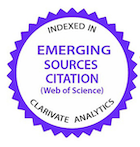Effects of maternal nutrition in the final third of gestation on performance and body composition of progeny at slaughter
DOI:
https://doi.org/10.1590/1809-6891v24e-74730EAbstract
This study aimed to assess how maternal nutrition in the final third of gestation affects progeny weight performance and body composition. Forty-one steers were included, born to cows subjected to different nutritional levels during this period: 13 cows without supplementation and under nutritional restriction (RES), 16 cows supplemented to meet 100% of requirements (REQ), and 12 cows supplemented to meet 150% of requirements (HIGH). The study design was completely randomized. Progeny performance was not influenced by maternal nutrition during gestation (P > 0.05). However, RES animals excelled during challenging periods, while REQ and HIGH animals performed better in nutritionally favorable environments. Maternal nutrition in the final third of gestation did not impact the contribution of non-carcass components (16.42%) and internal organs (3.17%). RES and HIGH steers had a higher relative weight of the rumen (2.48%) compared to REQ steers (2.24%), resulting in a greater proportion of the gastrointestinal tract (8.25% vs. 7.63%). Carcass characteristics did not differ significantly between treatments (P > 0.05), with an average hot carcass weight and yield of 304.28 kg and 57.80%, respectively. The primary fore, side, and hind cuts represented 39.22%, 10.64%, and 50.67% of the carcass, respectively. Overall, maternal nutrition during gestation affects fetal development, leading to modifications in body composition and, consequently, the productive potential of the offspring.
Keywords: carcass yield; gastrointestinal tract; slaughter weight; vital organs
Downloads
References
Reynolds LP, Caton JS. Role of the pre- and post-natal environment in developmental programming of health and productivity. Molecular and Cellular Endocrinology. 2012; 354 (1): 54-59. https://doi:10.1016/j.mce.2011.11.013
Klein JL, Machado DS, Adam SM, Alves Filho DC, Brondani IL. Efeitos da nutrição materna na gestação sobre a qualidade da progênie - uma revisão. Research, Society and Development. 2021; 10 (2): e45710212654. http://dx.doi.org/10.33448/rsd-v10i2.12654
Brameld JM, Greenwood PL, Bell AW. Biological Mechanisms of Fetal Development Relating to Postnatal Growth, Efficiency and Carcass Characteristics in Ruminants. In: Greenwood PL, Bell AW, Vercoe PE, Viljoen GJ (editors). Managing the prenatal environment to enhance livestock productivity. Springer Dordrecht Heidelberg London New York; 2010. p. 93-120. https://doi.10.1007/978-90-481-3135-8
Reynolds LP, Borowicz PP, Caton JS, Crouse, MS, Dahlen CR, Ward AK. Developmental programming of fetal growth and development. Veterinary Clinics of North America: Food Animal Practice. 2019; 35 (1): 229-247. https://doi.org/10.1016/j.cvfa.2019.02.006
Duarte MS, Gionbelli MP, Paulino PVR, Serão NVL, Martins TS, Tótaro PIS, Neves CA, Valadares Filho SC, Dodson, MV, Zhu M, Du M. Effects of maternal nutrition on development of gastrointestinal tract of bovine fetus at different stages of gestation. Livestock Science. 2013; 153 (1): 60-65. http://dx.doi.org/10.1016/j.livsci.2013.01.006
Da Cruz WFG, Schoonmaker JP, Resende FD, Siqueira GR, Rodrigues LM et al. Effects of maternal protein supplementation and inclusion of rumen‐protected fat in the finishing diet on nutrient digestibility and expression of intestinal genes in Nellore steers. Animal Science Journal 2019; 90 (1): 1200-1211. https://doi:10.1111/asj.13273
Symonds ME, Sebert SP, Budge H. Nutritional regulation of fetal growth and implications for productive life in ruminants. Animal. 2010; 4 (7): 1075-1083. https://doi:10.1017/S1751731110000479
Prezotto LD, Camacho LE, Lemley CO, Keomanivong FE, Caton JS, Vonnahme KA, Swanson KC. Nutrient restriction and realimentation in beef cows during early and mid-gestation and maternal and fetal hepatic and small intestinal in vitro oxygen consumption. Animal. 2016; 10 (5): 829-837. https://doi:10.1017/S1751731115002645
Funston RN, Martin JL, Adams DC, Larson DM. Winter grazing system and supplementation of beef cows during late gestation influence heifer progeny1. Journal of Animal Science. 2010; 88 (1): 4094-4101. https://doi:10.2527/jas.2010-3039
NRC - National Research Council. Nutrient requirements of beef cattle. Washington: National Academy Press. 1998. 24p.
Klein JL, Adam SM, De Moura AF, Alves Filho DC, Maidana FM, Brondani IL, Cocco JM, Rodrigues LDS, Pizzuti LAD, Da Silva MB. Productive performance of beef cows subjected to different nutritional levels in the third trimester of gestation. Animal. 2021; 15 (1): 100089. https://doi.org/10.1016/j.animal.2020.100089
NRC - National Research Council. Nutrient requirements of beef cattle. 7th ed. Washington: National Academy Press. 2000. 249p.
Cattelam J, Brondani IL, Alves Filho DC, Argenta FM, Siqueira Junior V, Martini PM. Efeito heterótico nas partes não-integrantes a carcaça de novilhos terminados em confinamento. Ciência Animal Brasileira. 2014; 15 (2): 174-186. http://dx.doi.org/10.1590/1809-6891v15i228081
Müller L. Normas para avaliação de carcaças e concurso de carcaça de novilhos. 2th ed. Santa Maria: Universidade Federal de Santa Maria. 1987. 31p.
SAS - Statistical Analysis Systems Institute. User’s guide version 3.5 SAS™ Studio University Edition. Cary, New York, USA, 2016.
Hyttel P, Sinowatz F, Vejlsted M. Embriologia veterinária. 1th ed. Rio de Janeiro: Elsevier. 2012. 455p.
Mohrhauser DA, Taylor AR, Underwood KR, Pritchard RH, Wertz-Lutz AE, Blair AD. The influence of maternal energy status during midgestation on beef offspring carcass characteristics and meat quality. Journal of Animal Science. 2015; 93 (1): 786-793. http://dx.doi.org/10.1016/j.meatsci.2015.07.017
Webb MJ, Block JJ, Funston RN, Underwood KR, Legako JF, Harty AA, Salverson RR, Olson KC, Blair AD. Influence of maternal protein restriction in primiparous heifers during mid and/or late-gestation on meat quality and fatty acid profile of progeny. Meat Science. 2019; 152 (1): 31-37. https://doi.org/10.1016/j.meatsci.2019.02.006
Vaag AA, Grunnet LG, Arora GP, Brons C. The thrifty phenotype hypothesis revisited. Diabetologia. 2012; 55 (1): 2085-2088. https://doi:10.1007/s00125-012-2589-y
Ramírez M, Testa LM, Valiente SL, Latorre ME, Long NM, Rodriguez AM, Pavan E, Maresca S. Maternal energy status during late gestation: Effects on growth performance, carcass characteristics and meat quality of steers progeny. Meat Science. 2020; 164 (1): e 108095. https://doi.org/10.1016/j.meatsci.2020.108095
Du M, Huang Y, Das AK, Yang Q, Duarte MS, Dodson MV, Zhu MJ. Manipulating mesenchymal progenitor cell differentiation to optimize performance and carcass value of beef cattle. Journal of Animal Science. 2013; 91 (3): 1419-1427. https://doi:10.2527/jas2012-5670
Maresca S, Valiente SL, Rodriguez AM, Testa LM, long NM, Quintans GI, Pavan E. The influence of protein restriction during mid to late gestation on beef offspring growth, carcass characteristic and meat quality. Meat Science. 2019; 153 (1): 103-108. https://doi.org/10.1016/j.meatsci.2019.03.014
Published
How to Cite
Issue
Section
License
Copyright (c) 2023 Brazilian Animal Science/ Ciência Animal Brasileira

This work is licensed under a Creative Commons Attribution 4.0 International License.
Authors who publish with this journal agree to the following terms:
- Authors retain copyright and grant the journal right of first publication with the work simultaneously licensed under a Creative Commons Attribution License that allows others to share the work with an acknowledgement of the work's authorship and initial publication in this journal.
- Authors are able to enter into separate, additional contractual arrangements for the non-exclusive distribution of the journal's published version of the work (e.g., post it to an institutional repository or publish it in a book), with an acknowledgement of its initial publication in this journal.
- Authors are permitted and encouraged to post their work online (e.g. in institutional repositories or on their website) prior to and during the submission process, as it can lead to productive exchanges, as well as earlier and greater citation of published work (See The Effect of Open Access).































